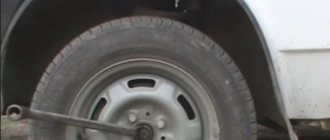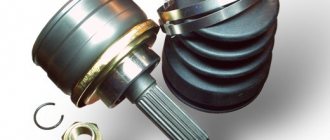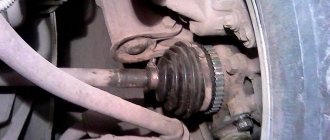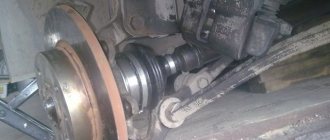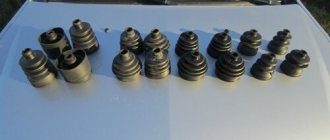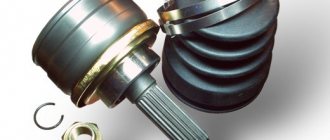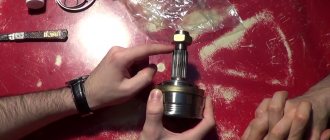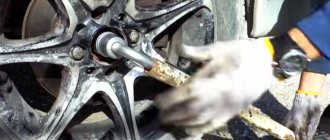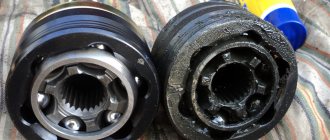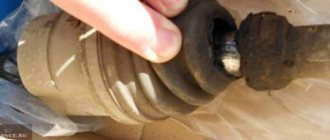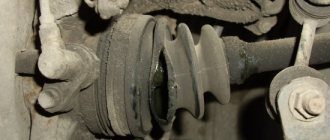Causes and breakdowns
In reality, the resource of the CV joint turns out to be significantly less, which is caused by operating conditions, poor quality of roads, driving habits and other factors.
The CV joint is popularly called a “grenade,” which is due to the external similarity of the element to this explosive device.
Here's what you should know about grenade malfunctions:
- Practice shows that the most common cause of CV joint failure is dirt, dust, and sand that enter the mechanism through a damaged boot;
- Sometimes the problem of a non-functioning grenade can be solved by replacing the boot. This is possible if the CV joint itself has not yet worn out due to exposure to contamination;
- If the damaged boot is not detected in time, the grenade will be completely worn out within literally 200 kilometers;
- If the CV joint fails, a strong crunching sound appears when cornering and accelerating. Such a symptom indicates the need to urgently replace the CV joint;
- The cost of new grenades is quite affordable; they are available at any auto parts store. But you should purchase those that meet the technical requirements of the VAZ 2109;
- If you have at least a little experience in repairing cars yourself, it is quite possible to replace a grenade with your own hands.
Types of CV joints
Before you begin repairs, you need to find out exactly how the unit is designed.
The pair of drives on the VAZ 2109 is equipped with a total of 4 CV joints.
| CV joint type | Peculiarities |
| Interior | There are 2 of them. They transmit torque to the axle shaft from the gearbox |
| Outer | There are also two of them. Installed on the ends of the axle shafts and transmit torque directly to the wheels |
This arrangement of grenades allows the wheels to rotate during turns and constant operation of the suspension system. To put it simply, the outer CV joints are responsible for transmitting torque when cornering, and the inner ones are responsible for the vertical movement of the wheels. These are collisions with bumps, holes, roll in turns, etc.
Types of auto parts
Various types of CV joints are sold. Among all the diversity, it is worth highlighting the following types:
- Twin cardan joints (these are two cardan joints mated to each other).
- Tripod (allow large axial movements).
- Ball ones (are the most common).
- Cam-disk (KrAZ-255B, Ural-4320).
- Crackers (prone to overheating at high shaft rotation speeds, installed more often on cargo vehicles).
A grenade can also be:
- Internal (connects the axle shaft and gearbox).
- External (connects the wheel hub to the axle shaft).
Depending on the condition of the CV joint, you can purchase:
- New.
- Old, in working order.
- Used, requiring replacement of individual components.
Different factories can produce grenades for the VAZ 2109. Based on this, parts are classified into two types:
According to the manufacturer, CV joints can be of the following brands:
Grenades for VAZ 2109 are sold at various sales points. Therefore, you can buy a car part:
Step-by-step CV joint replacement
Unfortunately, not each of us has the opportunity to use an overpass or pit to repair our car, and we have to go to a service station to repair even simple car components. However, prices and quality of service in these services very often force you to postpone repairing your car until “better times.” Therefore, I recommend reading an article that will allow you, using some techniques, to replace a unit that requires a hole - without it.
The drive of each wheel consists of two constant velocity joints (CV joints) connected to each other by a shaft. The CV joint located closer to the gearbox is called internal, and the one located closer to the wheel is called external. The outer CV joint ensures rotation of the wheel to the required angle, and the inner one provides angular and axial movement of the drive shaft.
Rice. 1 — Wheel turning pattern
As can be seen in the figure, the outer CV joint allows you to change the direction of rotation at a much larger angle than the inner one. But in addition to changing the direction of rotation, the internal joint compensates for the axial movements of the shaft caused by the steering geometry of the front wheels. Despite the fact that the outer and inner hinges are links of the same chain, the outer one fails much faster. This is explained by the fact that the dynamic loads on the wheel are much higher than on the gearbox.
The outer joint is replaced when there is obvious wear, namely a characteristic crunch in motion when the wheel is turned at a large angle. A crunch when starting the car indicates wear on the inner joint.
Determining the malfunction
First of all, when driving, there may be extraneous noise from the front. First you need to make sure that the CV joint boots are not torn and there are no cracks or oily marks on the surface. To check, just turn the steering wheel all the way and carry out a visual inspection behind the wheel.
Found any damage? Change the boot immediately so that stones, small particles, and water do not subsequently get into the CV joint mechanism. Otherwise, the hinge will quickly become unusable.
It is quite easy to determine the need to replace the hinge itself - during turning maneuvers the driver notices characteristic knocking noises. The presence of play during swinging of the drive shaft will help confirm this fact.
Tool
Tools needed to replace the outer CV joint:
— a “30” head with a long handle (for unscrewing the hub nut); — head on “19” (for unscrewing wheel bolts); — head at “16”; - jack; — bricks or hemp (for hanging the front of the car); — WD-40; - flat (slotted) impact screwdriver; - wire cutters; - hammer; — a new set of outer CV joints.
Rice. 2 - Necessary tool
Note:
Contrary to popular belief, to replace the outer CV joint it is not necessary to drain the oil from the gearbox.
Preparatory work
Before replacing the CV joint boot or the grenade itself, you need to perform several preparatory steps. Without this, withdrawal is impossible. Please note that you cannot remove both inner joints at the same time - this will lead to destruction of the differential mechanism.
If the bevel gears fall off, you will have to remove the gearbox and completely disassemble it. Preparation includes the following steps:
- Complete or partial drainage of oil from the gearbox. When removing the internal CV joints, oil will spill out; to prevent this from happening, it is necessary to drain at least 2/3 of the total volume.
- Unlocking the front wheel hub nut (or both, if two drives need to be repaired).
- Loosening the hub nut and wheel bolts. The hub must be unscrewed using a 30mm wrench with a large lever.
- Removing the wheel after installing the side to be repaired on the jack and support.
Having completed the preparatory work, you can begin directly replacing the VAZ-2109 CV joint.
Removing the hinge
It is advisable to treat all unscrewed bolts and nuts with WD-40 a day before replacing the outer hinge, thus significantly reducing the effort spent on unscrewing these elements. If this is not possible, we process the bolts and nut immediately before starting repair work.
Rice. 3 - Place of treatment with WD-40
Rice. 4 - Areas of treatment with WD-40
Set the car's steering wheel straight, engage first gear and apply the parking brake. For those for whom it does not work, I suggest reading this article. Under the front wheel, in which the outer joint is changing, we install two bricks, as shown in the figure below, to prevent rotation and scrolling. Use an impact screwdriver to loosen the nut. Using a “30” socket with a long handle, unscrew the hub nut, turning the wrench counterclockwise, regardless of which side the CV joint is being replaced from (!).
Rice. 5 — Unscrewing the hub nut
Having removed the nut, unscrew it and remove the washer. Then loosen the wheel bolts and jack up the front wheel. We place stump or bricks under the front side member so that when the jack is removed, the front wheel still remains raised a few centimeters above the ground. Now you need to hang the other front wheel in the same way. This is necessary in order to break the transmitted force from one suspension to another through the transverse stability beam. Then unscrew the wheel bolts and remove the wheel from the side we need. The result should be the same as in the figure below.
Rice. 6 — Hanging the front wheels using bricks
Now, using the “16” head, you need to unscrew the two bolts securing the ball joint to the steering knuckle. It’s not very convenient to do this without a hole, but it’s quite possible.
Rice. 7 — Unscrewing the ball joint bolts from the steering knuckle (body elements have been removed for clarity)
Next, move the strut to the side so that the outer hinge comes out of the hub.
Rice. 8 — Output of the outer hinge from the hub
We loosen the clamps of the CV boot and remove them, and cut the boot itself so that it does not interfere. To remove the outer joint from the shaft, you need to use a flat (slotted) impact screwdriver to crawl between the retaining ring and the joint separator, and use a lever to pull it off the drive shaft, while holding the shaft with the other hand, as shown in the figure below.
Attention! Never pull the drive shaft towards you, as it may come out of the inner joint!
Rice. 9 — Removing the CV joint using a screwdriver
Rice. 10 — Installing a screwdriver between the retaining ring and the hinge separator
If you did it as shown in the figure, the hinge should be easily removed from the shaft. Replacing the locking half-ring is completely optional if its external integrity is intact. Then we take out a set of new outer CV joint and get ready for installation.
Installation
We take out the boot and put it on the drive shaft, after which we fix its inner part with a small clamp. The fixing process is very simple - after the hole gets into the recess, we tighten the clamp using wire cutters. Inside the boot we place at least 40 cm3 (the equivalent of two matchboxes) of CV joint grease-4, which comes complete with the new hinge.
Rice. 11 — Installing the boot and clamp tie
Attention! Never reuse parts such as clamps and hub nuts, as these parts are disposable!
After this, we put on the hinge and, with light blows of a hammer, hammer it in until it stops. We put on the boot and secure it with a large clamp, similar to the small one. Now you need to get the hinge splines into the spline hole of the hub, and then put on the washer and hub nut. Next, we bring the strut into position above the ball joint and tighten the pre-oiled bolts.
Rice. 12 — Installing a new hinge
Rice. 13 — Clamp tie
Note:
It is recommended to lubricate all bolts discussed in this article. This will slow down the oxidation of the bolts, and in the future will allow you to unscrew them with less effort.
We put on the wheel and first tighten the oiled wheel bolts. Next, you need to lower the car onto the wheels, and then place bricks under the “operated” wheel. Tighten the wheel bolts with normal force and the wheel nut with a torque of 220 Nm. If there is no special wrench, tighten the nut with maximum force, after which you need to lock it using an impact screwdriver and a hammer.
After the car has driven 500-1000 km, re-check the tightness of the ball joint bolts and, if necessary, tighten them.
CV joint assembly process
When assembling the outer CV joint, you must perform the following steps:
- We put a rubber part on the shaft.
- We stuff the CV joint (new or cleaned) onto the shaft until the part is secured with a retaining ring.
- We place fresh lubricant in the hinge and boot.
- We put the boot on the outer race.
- We remove excess air from the boot by pressing it with your hand.
- We secure the boot with clamps.
Then the drive is put in place, the hub is clamped with a nut. It is also necessary to put back the tie rod end, support and wheel. Next, you can lower the jack and tighten the nut securing the drive. To prevent it from unscrewing on its own, the nut should be capped.
Features of repairing the internal CV joint
To replace the inner CV joint, it is necessary to completely remove the drive, for which the outer joint is first disconnected without subsequent dismantling. Next, using a pry bar, remove the hinge end from the gearbox. To do this, we insert the flat part of the tool between the outer frame and the box, and then move it like a lever.
Further, the procedure for replacing the unit will be similar to the actions when repairing the external hinge. The inner CV joint must be correctly inserted into the transmission. It is recommended to insert the part into the hub, with the help of which the unit is brought into place by pushing movements. But it is also possible to drive the already assembled shaft with a mallet or a wooden pointer and a hammer. The hinge must be secured with a locking ring.
At the final stage, all removed parts are installed back. At this point, the replacement of CV joints is considered completed.
How to remove the drive
In order to remove the drive assembly, you need to perform the following steps:
- Completely unscrew the nut on the outer joint to free the hub.
- Remove the nuts from the bolts that secure the strut to the hub steering knuckle. This will allow you to move the hub to free the joint. But it will be much more efficient not to unscrew the nuts on the strut, but to disconnect the ball joint.
- If you unscrewed the ball joint, you need to remove the tie rod end pin from the hole in the strut knuckle. This is done using a special puller.
- Now you need to pull the outer joint out of the hole in the hub. How to do this depends on the situation. You can use a thin drift, but without fanaticism, so as not to damage the mechanisms. You should also not hit the CV joint axle with a hammer - this will cause the edges to flatten and make it impossible to remove the element.
- After you pull out the outer joint, you can proceed to the inner one - to remove it from the hole in the gearbox, just apply a few light blows with a small chisel. You can also use a mounting spatula.
That's all, now the drive has been completely removed, you also need to learn how to remove the CV joint on a VAZ-2109.
